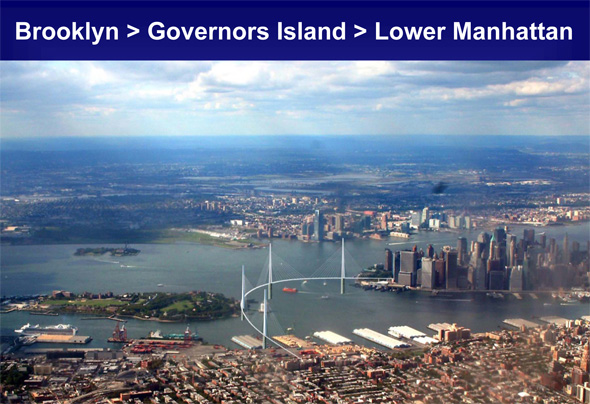Sam Schwartz's proposal to collect a half-a-buck per bicycle entry on bridges to the Manhattan Central Business District is putting New York cyclists in a bind. Cyclists, like drivers, don't relish paying for something they've been getting for free, particularly when they feel they're being singled out. Yet Schwartz's bike-toll idea is merely one part, and a minor one at that, of an audacious scheme to restructure bridge and road tolls across the city and revolutionize travel by car, bike, train and bus. If a bike toll can help sell the grand plan — and Schwartz insists it can — it might be a price worth paying.
Full disclosure first: I'm helping Sam with quantitative analysis of his plan; my BTA model runs its numbers. But my connections to Sam go back much further. In 2009, he hosted a briefing in which I showcased the BTA to other transportation wonks, and his rave for the model in Wired magazine was a big boost for me. I’ve been a Gridlock Sam admirer for decades, captivated by his ability — unique among policy types — to speak the language of the person he’s talking to: cab driver, planner, politician.
So when Sam tried out his bike-toll idea on me months ago, I listened. You can sell easier with honey than vinegar, the saying goes, and Sam's plan slathers on the honey with a 50 percent drop in tolls on MTA bridges like the Verrazano and the Throgs Neck that connect one outer borough to another. But not even honey packs the zest of sticking it to someone you can’t stand. "You’re going to make the bikers pay to pedal into Manhattan?," marveled one elected official, an opponent of Mayor Bloomberg's congestion pricing plan, after seeing Sam’s plan in slideshow. "Wouldn't it be funny if I introduced this plan?"
The plan Sam wants to sell would charge a uniform ten bucks for each auto round-trip into the CBD, whether via the Hudson, the East River, or 60th Street. After slashing outer-borough bridge tolls, paying for the tolling system and discounting bus fares in the city’s non-subway-served precincts, there would still be $1.2 billion a year left over to invest in infrastructure. Sam would apply most of that to expand transit routes and improve service without bonding that adds pressure to fares. Some would go to highways — Sam is convinced that widening the Belt Parkway to allow trucks will take dangerous commercial traffic off Brooklyn streets. And some will go to the bicycle bridges.
Ah, Sam’s bicycle bridges. One from Jersey City and Hoboken would land north of Chelsea Piers. Another from Long Island City and Hunter’s Point would touch down in East Midtown. The third would skip from Red Hook to the Finanical District via Govenor’s Island. In Sam’s drawings, they’re gossamer wings that set dreams alight. Othmar Ammann, the Swiss-American engineer who designed New York’s iconic spans — the George Washington, Bayonne, Throgs Neck, Bronx-Whitestone and Verrazano Bridges — would be garlanding the new bridges with roses.
I admit that Sam sold me on his 50-cent bike toll by tying it to these bridges. For one thing, digital debit cards to collect the tolls from moving cyclists might not even be viable before the bridges' 2020 commissioning target date. And paying to cycle on a bridge built expressly for cycling (and walking) is both fair and strategic. Paying to bike on a long-since-built East River bridge is less of a slam dunk.
But Sam, a veteran of the 1970s-1980s era of infrastructure disinvestment, when three East River bridges lost their bike lanes and the fourth, the Brooklyn, nearly came apart as well, takes a longer view. "Bike infrastructure needs a dedicated revenue stream," he says. "And if the goal is to legitimize bikes — I mean really legitimize them — what better way than to have cyclists pay into a bicycle fund?"
I'm Sam's contemporary, and I too go for the longer view. I've been working my tail off for five years to enact a universal toll to drive into Manhattan, but it's a campaign that’s been waged on and off for 40 years. Sam has as much skin in the game as anyone, and now he's got a traffic-pricing plan that looks like it can do it all: co-opt the naysayers, improve every mode of travel in every part of the city, and create benefits — saved time, improved health and a better environment and quality of life — worth $4 billion a year.
Do we cyclists really feel we shouldn’t have to give up anything to grab this brass ring, especially when the benefits include a predicted 50 percent increase in cycling by virtue of the drop in car traffic making biking easier and safer? Is our tab of $10 million a year, vs. $300 million for taxi users and $1 billion for drivers, really too high a price to advance a plan that would do so much for our city while finally establishing traffic-pricing in the USA?
Remember what I said at the top, that no one wants to pay for what’s now free? That’s what motivated congestion pricing opponents when they outmuscled John Lindsay in 1973, Ed Koch in 1986, and Mike Bloomberg in 2007-08. Swallowing a modest bike toll so we cyclists can talk down outer-borough drivers who don’t want to pay for what’s now free could be a slam dunk after all.






